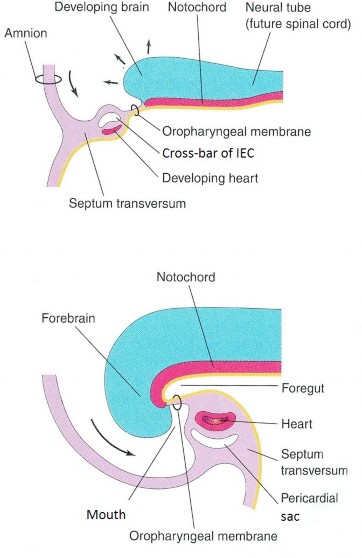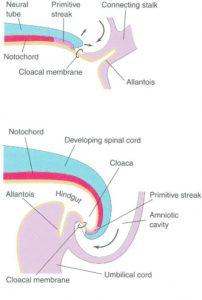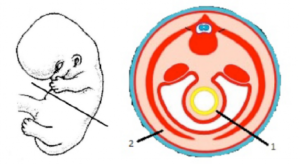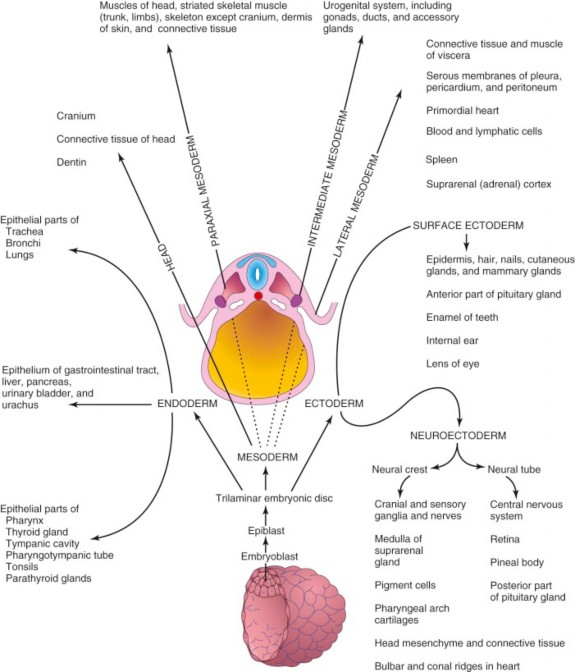The human body form arises through cranial, caudal, and lateral folding of the embryonic disc.
Hold onto your seats, folks . . .
- At the end of the 3rd week, the trilaminar embryonic disc is flat and oval in shape. During the 4th week, the disc grows rapidly, especially in length, and undergoes a complicated process of folding.
- The main forces responsible for folding the disc into the recognizable vertebrate body form appear to be differences in the growth rates and in the rigidity of certain tissues—some parts of the embryo grow faster than others, creating forces that bend the disc, and certain parts of the embryo are more rigid and act as the fulcrums where bending occurs.
- During the 4th week, the embryonic disc and amniotic sac on the dorsal side of the disc grow rapidly, but the yolk sac located ventral to the disc does not keep pace. Differential growth raises up the dorsal side of the disc and amniotic sac and folds them ventrally around the yolk sac—which appears to shrink in comparison since it does not grow nearly as fast.
- The notochord, neural tube, and somites provide stiffness to the dorsal side of the embryonic disc, so most of the folding of the disc occurs at its flexible, outer rim. The cranial, caudal, and lateral margins of the disc fold and “tuck” ventrally, under the dorsal axis of the embryo, giving rise to the ventral surface of the body. This produces an elongated embryo, resembling a tadpole. The embryo grows fast in the cranial region where the neural tube is growing into the expanded cerebrum of the brain. Therefore, the folding of the embryonic disc is more pronounced and dramatic in the head region.

Figure 2.21 MOORE ET AL., THE DEVELOPING HUMAN, FIGURE 8-4.
Realize that folding of the embryo occurs simultaneously in all directions. However, to keep us sane, we will break the process down into 3 folds:

The rapid growth of the cranial part of the neural tube (brain) induces the cranial rim of the embryonic disc to fold and “tuck under.” This produces the ventral surface of the future head, neck, and chest.
Within the “head” mesoderm are subsets of tissues that will form the heart (cardiogenic mesoderm) and the diaphragm (septum transversum). These primordial tissues along with the oropharyngeal membrane (future mouth) are located cranial to the developing neural tube before folding. After head folding,the definitive locations of the diaphragm and heart in the thorax, and the opening of the mouth on the face, are established, caudal to the brain. See the before and after in Figure 2.22.
Summary: Results of the head fold
- The ventral parts of the head, neck, and thorax are created from ectoderm and somatic mesoderm. The ventral wall of the thorax encloses the upper part of the body cavity = the thoracic cavity. Three serous sacs will develop within the thoracic cavity.
- The endoderm and associated splanchnic mesoderm in the cranial region of the embryonic disc are rolled into a tube and located within the embryo dorsal to the mouth and heart, producing the cranial part of the digestive tube (= the foregut). Endoderm gives rise to the inner epithelium and splanchnic mesoderm surrounds the endoderm, giving rise to smooth muscle, connective tissues, and blood vessels of the foregut.
- The “cross-bar” portion of the intra-embryonic coelom and the developing heart are placed ventral to the foregut, the developing heart being dorsal to the IEC, between it and the gut. The part of the IEC adjacent to the heart will become a serous sac known as the serous pericardium. The cross-bar part of the intra- embryonic coelom is bent forward and now takes on the shape of (old-fashioned) “bicycle handlebars,” rather than a horseshoe. The cross bar portion of the handlebars will be partitioned into three serous sacs = the serous pericardium and two pleural sacs.

Figure 2.22 MOORE ET AL., THE DEVELOPING HUMAN, FIGURE 8-4. - The septum transversum, the cranial-most part of the head mesoderm, is moved caudal to the future heart and pericardium, between these structures and the neck of the yolk sac. The septum transversum will give rise to a major part of the future diaphragm.

Similar to the head fold, the growing neural tube, amniotic sac, and somites overgrow the caudal rim of the embryonic disc. The caudal portion of the embryonic disc containing the cloacal membrane folds under the dorsal embryonic surface, becoming part of the embryo’s ventral surface. This explains the location of the anus anterior to the tip of the coccyx (and you thought the anus was on the “backside” of the body!). The tail fold also carries the connecting stalk (connecting the caudal end of the embryonic disc to the developing placenta) cranially until it abuts the yolk sac. See the before and after figures in Figure 2.23.
Summary: Results of the tail fold
-
The lower part of the ventral body wall is formed from ectoderm and somatic mesoderm.
- The connecting stalk attaches to the ventral body wall. The connecting stalk (and other tissues) gives rise to the umbilical cord. The tail fold translocates the developing umbilical cord to the ventral body wall, thus producing the region of the region of the abdominal wall that contains the future umbilicus (“belly button”).
- Endoderm in the caudal region of the embryonic disc is rolled into a tube and placed within the folded embryo, giving rise to the epithelial lining of the tail-end of the embryonic digestive tube (= the hindgut). Splanchnic mesoderm surrounds the endoderm, forming smooth muscle, blood vessels, connective tissues, and serous membranes of organs of the hindgut (e.g., descending colon, rectum).
Note: The allantois is a diverticulum of the hindgut that figures later in the development of the urinary bladder.

Concurrent with caudal and cranial folding, the embryonic disc is also folding ventrally along its left and right edges. Lateral folding of the disc will give the embryo its oval shape as viewed in transverse section. The two lateral folds, the head fold, and the tail fold all tuck under, ventrally; converging like the edges of a purse being closed by a purse- string around the yolk sac and umbilical cord. Folding of the embryonic disc causes the yolk sac to become elongated and constricted where the caudal, cranial, and lateral rims of the embryonic disc meet and impinge upon it. This connection between yolk sac and folded embryo is called the vitelline duct. It later regresses and should disappear.
Summary: Results of lateral folding
-
Ectoderm and somatic mesoderm from the left and right sides of the embryonic disc fuse in the midline completing the ventral body wall and enclosing the body cavity. Later, the development of the diaphragm separates the single body cavity into thoracic and abdominopelvic cavities.
- The right and left coelomic ducts (of the IEC) come together and fuse to form a serous sac in the abdominopelvic cavity (= the peritoneal sac). Somatic mesoderm gives rise to the parietal peritoneum; splanchnic mesoderm forms the visceral peritoneum.
- Endoderm in the central region of the embryonic disc is rolled into a tube forming the epithelial lining of the mid-portion of the primitive digestive tube (= the midgut). Splanchnic mesoderm surrounds the endoderm, forming the smooth muscle, blood vessels, connective tissues, and serosa of midgut organs.
Clinical correlation
Failure of the lateral folds to fuse properly is one possible cause of ventral body wall defects. One type, gastroschisis, produces a fissure in the anterior abdominal wall near the umbilical cord, with protrusion of abdominal viscera into the amniotic cavity. (See Figure 2.25 and Gastroschisis.)

Figure 2.25. Gastroschisis. Children’s Hospital of Philadelphia, Center for Fetal Diagnosis and Treatment. Gastroschisis.
Folding of the embryonic disc closes the body wall around the body cavity

Note that the tube-within-a-tube design of the vertebrate body is now complete. The gut tube (tube 1) is located within the body cavity surrounded by the body wall (tube 2). This distinction between the “inner” and “outer” tubes is important because they have different origins and innervations:
- From splanchnic mesoderm and endoderm
- “Visceral” type of innervation from autonomic nervous system
- Pain from these organs is often referred to somatic body parts.
- From somatic mesoderm and ectoderm
- “Somatic” type of innervation from peripheral nerves
- Pain from these areas is usually sharp and well-localized.
- Tying it all together
Below are links to helpful videos:
Division of the intraembryonic coelom by the diaphragm
- The development of the diaphragm (from septum transversum and other tissue sources) divides the IEC into two cavities:
- The thoracic cavity is cranial to the diaphragm,
- The abdominopelvic cavity is caudal to the diaphragm.
- Recall that the head fold translocates the septum transversum from the cranial region of the embryonic disc to the thorax. Before folding, muscle-forming cells in the septum become associated with nerve fibers originating from cervical spinal nerves (C-3, -4, and -5). These nerve roots fuse to form the phrenic nerves. Indeed, long nerves originating in the neck innervate the diaphragm! It’s because of the head fold, of course!
Formation of the intraembryonic coelom forms the peritoneal, pleural, and pericardial sacs
- The peritoneal sac develops from the portions of IEC caudal to the diaphragm (the left and right limbs of the IEC = coelomic ducts). This will be discussed further in the chapter on gut development.
- The pleural sacs and serous pericardium develop from the portion of the IEC cranial to the diaphragm (the “bicycle handlebars”). This will be discussed further in the chapter on Lungs.
summary
The diaphragm divides the IEC into thoracic and abdominopelvic cavities. One serous sac develops below the diaphragm in the abdominopelvic cavity. What is its name?
summary
Three serous sacs develop within the thoracic cavity. What are their names?
Fates of ectoderm, mesoderm, and endoderm

Figure 2.27 MOORE ET AL., THE DEVELOPING HUMAN, 10TH ED., FIGURE 5-5.
You should know the definitive structures in the body that are derived from ectoderm, mesoderm (and its subdivisions), and endoderm. These are summarized below:
Epidermis of skin (surface ectoderm), the central nervous system (neuro-ectoderm), and the many derivatives of neural crest (ganglia, medulla of suprarenal glands).
Produce somites (which in turn split into myotomes, sclerotomes, and dermatomes).
-
- Myotomes give rise to skeletal muscles of the back (paravertebral muscles) and trunk (prevertebral/body wall muscles).
- Sclerotomes give rise to bones of the thorax (ribs, sternum, and vertebrae).
Kidneys and gonads.
Parietal layer of serous membranes, hypodermis, and dermis of the skin in the body wall and limbs.
Visceral layer of serous membranes, smooth muscle and connective tissues in digestive tube and its derivatives (air tubes, liver, biliary, pancreas), heart and blood vessels, spleen, and cortex of the suprarenal glands.
Inner epithelium lining the digestive tube and the ducts of its accessory glands (liver, pancreas, etc.), as well the inner epithelial lining of air tubes (trachea, bronchi) and of the urinary bladder.